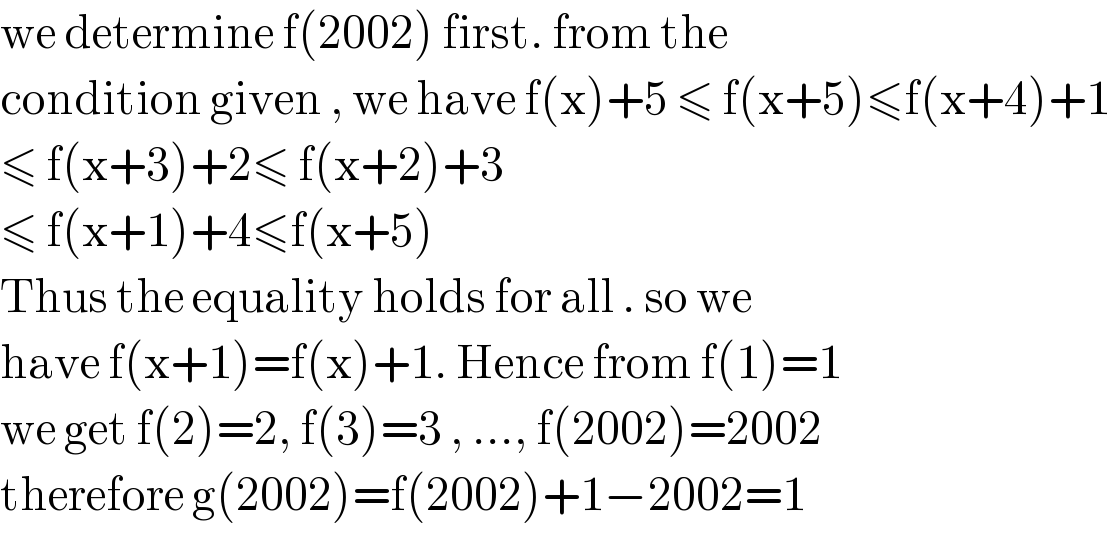
Previous in Relation and Functions Next in Relation and Functions
Question Number 96607 by bemath last updated on 03/Jun/20

$$\mathrm{It}\:\mathrm{is}\:\mathrm{given}\:\mathrm{that}\:\mathrm{f}\left(\mathrm{x}\right)\:\mathrm{is}\:\mathrm{a}\:\mathrm{function} \\ $$$$\mathrm{defined}\:\mathrm{on}\:\mathbb{R},\:\mathrm{satisfying}\:\mathrm{f}\left(\mathrm{1}\right)=\mathrm{1} \\ $$$$\mathrm{and}\:\mathrm{for}\:\mathrm{any}\:\mathrm{x}\in\mathbb{R},\:\mathrm{f}\left(\mathrm{x}+\mathrm{5}\right)\:\geqslant\mathrm{f}\left(\mathrm{x}\right)+\mathrm{5} \\ $$$$\mathrm{and}\:\mathrm{f}\left(\mathrm{x}+\mathrm{1}\right)\:\leqslant\mathrm{f}\left(\mathrm{x}\right)+\mathrm{1}.\:\mathrm{If}\:\mathrm{g}\left(\mathrm{x}\right)= \\ $$$$\mathrm{f}\left(\mathrm{x}\right)+\mathrm{1}−\mathrm{x},\:\mathrm{then}\:\mathrm{g}\left(\mathrm{2002}\right)\:=\:\_\_\_ \\ $$
Commented by bobhans last updated on 03/Jun/20

$$\mathrm{we}\:\mathrm{determine}\:\mathrm{f}\left(\mathrm{2002}\right)\:\mathrm{first}.\:\mathrm{from}\:\mathrm{the} \\ $$$$\mathrm{condition}\:\mathrm{given}\:,\:\mathrm{we}\:\mathrm{have}\:\mathrm{f}\left(\mathrm{x}\right)+\mathrm{5}\:\leqslant\:\mathrm{f}\left(\mathrm{x}+\mathrm{5}\right)\leqslant\mathrm{f}\left(\mathrm{x}+\mathrm{4}\right)+\mathrm{1} \\ $$$$\leqslant\:\mathrm{f}\left(\mathrm{x}+\mathrm{3}\right)+\mathrm{2}\leqslant\:\mathrm{f}\left(\mathrm{x}+\mathrm{2}\right)+\mathrm{3} \\ $$$$\leqslant\:\mathrm{f}\left(\mathrm{x}+\mathrm{1}\right)+\mathrm{4}\leqslant\mathrm{f}\left(\mathrm{x}+\mathrm{5}\right) \\ $$$$\mathrm{Thus}\:\mathrm{the}\:\mathrm{equality}\:\mathrm{holds}\:\mathrm{for}\:\mathrm{all}\:.\:\mathrm{so}\:\mathrm{we}\: \\ $$$$\mathrm{have}\:\mathrm{f}\left(\mathrm{x}+\mathrm{1}\right)=\mathrm{f}\left(\mathrm{x}\right)+\mathrm{1}.\:\mathrm{Hence}\:\mathrm{from}\:\mathrm{f}\left(\mathrm{1}\right)=\mathrm{1} \\ $$$$\mathrm{we}\:\mathrm{get}\:\mathrm{f}\left(\mathrm{2}\right)=\mathrm{2},\:\mathrm{f}\left(\mathrm{3}\right)=\mathrm{3}\:,\:...,\:\mathrm{f}\left(\mathrm{2002}\right)=\mathrm{2002} \\ $$$$\mathrm{therefore}\:\mathrm{g}\left(\mathrm{2002}\right)=\mathrm{f}\left(\mathrm{2002}\right)+\mathrm{1}−\mathrm{2002}=\mathrm{1} \\ $$
